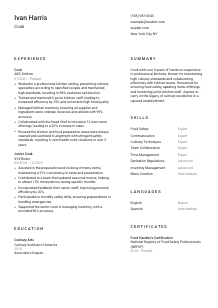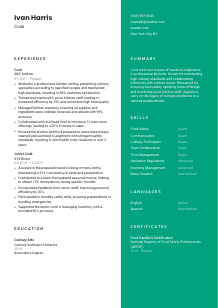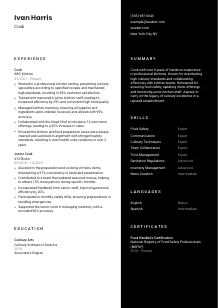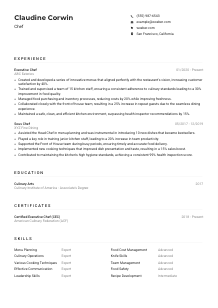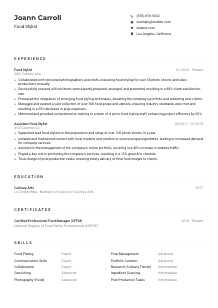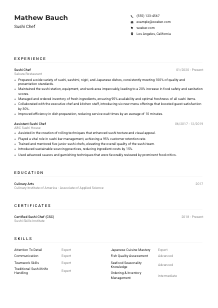Cook Resume Example
Crafting culinary delights, but your resume seems undercooked? Sizzle over to this Cook resume example, seared to perfection with Wozber free resume builder. Grasp how you can season your kitchen skills to match job tastes, ensuring your career heats up as appetizingly as the dishes you create!
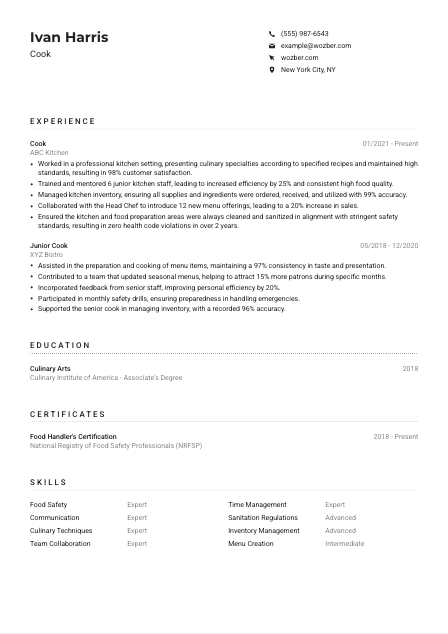
How to write a Cook Resume?
Hello, aspiring Cook ready to stir things up in the culinary world! Crafting a resume that not only showcases your skills but is also perfectly seasoned to meet the tastes of your prospective employers is key in the highly competitive culinary job market. With the right ingredients and the Wozber free resume builder at your disposal, we'll guide you through how to blend your experiences, skills, and accomplishments into a Michelin-worthy resume. So, grab your chef's hat, and let's cook up a resume that will open doors to kitchens you've always dreamed of working in.
Personal Details
Kicking off your resume with the Personal Details section sets the table for the feast of information that follows. It's not just about tossing in your name and contact information; it's about making sure even the appetizer of your resume is irresistible to hiring managers. Here's how to garnish this section to perfection:
1. Brand It with Your Name
Think of your name as the restaurant sign. Make it inviting and prominent. Choose a font that's clean and appetizing to the eye, setting a professional tone right from the start.
2. Match the Job Title
Placing "Cook" directly beneath your name, akin to a dish title on a menu, instantly aligns your resume with the job description. It's a subtle but effective way to tell the hiring manager, "This is the flavor you've been searching for."
3. Essential Contact Details are Like Your Ingredients
- Phone Number: Ensure it's your current number. A disconnected line is like a missing key ingredient; it ruins the experience.
- Professional Email Address: Keep it simple and professional. Your email should be as clear and straightforward as a well-written recipe.
4. Confirm Your Location
For a Cook, location can be as crucial as the right cooking temperature. The job description asks for someone in "New York City, NY." Make sure your resume confirms you're in the area, ready and set to report to the kitchen.
5. Add a Professional Profile Link
If you have a LinkedIn profile showcasing your culinary creations or professional accolades, include it. It's like offering a tasting menu to the hiring manager before they've even sat down for the main course.
Takeaway
The Personal Details section is your first chance to make an impression. It should be neat, professional, and aligned with the job posting. Think of it as your amuse-bouche, offering a tantalizing taste of what's to come.





Experience
The Experience section is where the heat is. It's your chance to showcase how you've already proved yourself in the kitchen. Tailoring this section to the job description creates a recipe for success. Here's how to simmer your experiences down to a rich, flavorful reduction:
- Worked in a professional kitchen setting, presenting culinary specialties according to specified recipes and maintained high standards, resulting in 98% customer satisfaction.
- Trained and mentored 6 junior kitchen staff, leading to increased efficiency by 25% and consistent high food quality.
- Managed kitchen inventory, ensuring all supplies and ingredients were ordered, received, and utilized with 99% accuracy.
- Collaborated with the Head Chef to introduce 12 new menu offerings, leading to a 20% increase in sales.
- Ensured the kitchen and food preparation areas were always cleaned and sanitized in alignment with stringent safety standards, resulting in zero health code violations in over 2 years.
- Assisted in the preparation and cooking of menu items, maintaining a 97% consistency in taste and presentation.
- Contributed to a team that updated seasonal menus, helping to attract 15% more patrons during specific months.
- Incorporated feedback from senior staff, improving personal efficiency by 20%.
- Participated in monthly safety drills, ensuring preparedness in handling emergencies.
- Supported the senior cook in managing inventory, with a recorded 96% accuracy.
1. Dissect the Job Requirements
With a chef's precision, cut through the job description. Highlighting phrases like "prepare and cook menu items" and "ensure the kitchen is cleaned and sanitized", equips you with the keywords and phrases to sprinkle throughout your Experience section.
2. Structure It Like a Menu
Organize your experience in a chronological order, like courses on a menu. Start with your most recent position at the top. For each role, list your job title, the name of your establishment, and the dates of your culinary tenure.
3. Accentuate Tasteful Accomplishments
Craft accomplishment statements that reflect both your responsibilities and your achievements, like reducing food waste or boosting customer satisfaction. These are your Michelin stars; display them prominently.
4. Quantify Your Culinary Conquests
Numbers are the universal language in kitchens worldwide. Quantify your achievements, whether it's the number of dishes prepared in a rush hour or the percentage increase in diner satisfaction. It provides a tangible measurement of your capabilities.
5. Marinate in Relevancy
Much like selecting ingredients for a dish, choose experiences that are most relevant to the role you're applying for. This ensures your resume is as appealing as a well-curated menu.
Takeaway
Your experience section is the main course of your resume; it should be rich with details of your culinary journey. By carefully selecting and presenting your experiences, you'll convince hiring managers that you're the secret ingredient they've been missing.
Education
Even the most naturals in the kitchen need a solid foundation in culinary arts education. Tailoring this section to your advantage can highlight how prepared you are to take on the kitchen's challenges head-first.
1. Garnish with Relevant Degrees
If you attended a culinary school, like the "Culinary Institute of America", this is where that degree shines. Though the job description didn't specify a requirement, this detail can elevate your resume like a fine truffle oil.
2. Plate It Neatly
Present your educational background cleanly and succinctly. Degree, field of study, institution, and graduation year are the key ingredients here.
3. Tailor with Culinary Precision
Focus on education that's directly relevant to being a Cook. Any additional courses or certifications that enhance your culinary skills belong here as well.
4. Sprinkle with Relevant Courses
List significant courses or workshops that align with the culinary arts, especially if they're directly applicable to skills emphasized in the job description, such as food safety or specific cooking techniques.
5. Add a Dash of Accomplishments
If you've won culinary school competitions or were a part of a prestigious internship, mention these achievements. They add flavor and depth to your educational background, much like a well-crafted sauce.
Takeaway
Your education section is more than a list of schools; it's proof of your commitment to culinary excellence. Tailor it carefully to reflect your readiness and enthusiasm for the challenges of a professional kitchen.
Certificates
Certificates in the culinary world are like badges of honor that tout your expertise and readiness for the kitchen's challenges. Here's how to present your credentials appetizingly:
1. Highlight Required Certifications
If the job profile asks specifically for a "Food Handler's or ServSafe certification", make sure yours is on display like a coveted kitchen award, complete with issuer and validity dates.
2. Selective Showcasing
Much like plating a dish, the presentation matters. Choose certifications that directly enhance your application. Additional certificates, such as those in advanced culinary techniques or specialty cuisines, can set you apart.
3. Freshness Counts
In the culinary world, freshness is key – and so it is with your certifications. Keeping your credentials up to date and relevant showcases your commitment to the craft.
4. Always Seasoning
The culinary field constantly evolves, and so should you. Highlight ongoing learning or recent certifications to demonstrate your pursuit of culinary excellence.
Takeaway
Certifications are the spices of your resume – they add essence and depth. Display them proudly, ensuring they're up-to-date and relevant. A well-seasoned resume is sure to catch the eye of your future kitchen team.
Skills
The Skills section is where you list the ingredients that make you a fantastic Cook. This is your chance to show off the professional skills that make you stand out in the culinary world. Let's delve into how to make this section as enticing as your signature dish:
1. Decode the Flavor Profile
Start with the job description and identify the skills it demands. Whether it's expertise in "Food Safety" or an "excellent communication" ability to collaborate, these are the flavors you want to bring out in your resume.
2. Blend Skills to Taste
Combine both hard and soft skills that match the job. A successful Cook not only has culinary prowess but also excels in time management and teamwork. Select skills that will complement the job's requirements.
3. Serve Neatly
Organize your skills in a manner that's easy for hiring managers to digest. A cluttered list is like an over-embellished dish; it can detract from the main components. Focus on those skills that add the most value.
Takeaway
Every skill you include in your resume is a testament to your culinary proficiency and your ability to handle the heat of the kitchen. Choose carefully, ensuring each skill contributes to the mouthwatering offering that is your resume.
Languages
In New York City's melting pot, the ability to speak multiple languages can significantly enhance your appeal as a Cook in diverse culinary settings. Let's add this international layer to your resume:
1. Taste Test the Job Description
First, identify if the job specifies a need for language skills. Here, "Proficiency in both oral and written English" is a key ingredient.
2. Prioritize Your Languages
List English first to directly match the job requirement, then follow with any additional languages. Being bilingual can be a unique advantage, especially in restaurants serving international cuisines.
3. Detail Your Proficiency Levels
Be clear about how well you speak, read, and write in each language. In the culinary world, this could mean accurately understanding recipes or communicating with a multicultural team.
4. Consider the Kitchen's Culture
Even if additional languages aren't specified, consider the cuisine and culture of the establishment. Knowing Italian in a traditional Italian restaurant, for example, could be your secret sauce.
5. Multilingual Mixer
Languages can enhance your resume like well-picked garnishes. They demonstrate your ability to connect with a broader spectrum of patrons and colleagues, enriching your culinary career.
Takeaway
Your linguistic abilities are like a well-stocked pantry – they can add depth and variety to your culinary creations. Flaunt your languages proudly, letting them showcase your capacity for connection and understanding in the culinary world.
Summary
The summary section is the appetizer of your resume, meant to whet the appetite of hiring managers for more. It wraps up your skills, experiences, and personal flair into a bite-sized portion. Here's how to craft a summary that leaves them craving more:
1. Digest the Job's Essence
Before you begin, internalize what the job entails. Reflect on how your skills and experiences make you the perfect candidate to fulfill these requirements.
2. A Sprinkle of Introduction
Start with an appetizing opener that introduces you as a professional. For instance, 'A passionate Cook with over 4 years of experience in bustling NYC kitchens.'
3. Add the Secret Ingredients
Mix in a few skills and accomplishments that align with the job's requirements. This could range from your expertise in food safety to your flair for creating new recipes. It's your recipe; make it flavorful.
4. Keep it Bite-Sized
A summary should be concise and punchy, giving just enough taste to intrigue. Think of it as the amuse-bouche of your resume – a single, elegant bite that sets the stage for what's to come.
Takeaway
Your summary is the first taste hiring managers will have of your professional capabilities. Make it memorable, tailored, and as delectable as your signature dish. This is your moment to shine; season it well.
Embarking on Your Culinary Journey
Congratulations, Chef-to-be! With your newly crafted resume in hand, seasoned with precision and presented with care, you're ready to take the culinary world by storm. Remember, your resume is just the beginning – it's the door to kitchens you've only dreamed of. Use the Wozber free resume builder, including its ATS-friendly resume templates and ATS resume scanner for keywords optimization, to ensure your resume is as ready as you are.
Now, apron up and show the world the flavors you're capable of creating. Bon appétit!

- Minimum of 3 years of experience in a professional kitchen setting.
- Strong knowledge of food safety and sanitation regulations.
- Proven ability to work in a fast-paced environment while maintaining high culinary standards.
- Excellent communication and interpersonal skills to collaborate with the kitchen team.
- Must possess a valid Food Handler's or ServSafe certification.
- Proficiency in both oral and written English required.
- Must be located in New York City, NY.
- Prepare and cook menu items according to the specified recipes and standards.
- Ensure the kitchen and food preparation areas are cleaned and sanitized in accordance with safety standards.
- Order, receive, and manage inventory of kitchen supplies and ingredients.
- Train and mentor junior kitchen staff, ensuring a high standard of food quality and presentation.
- Collaborate with the Head Chef or Manager to create and update menu offerings.





